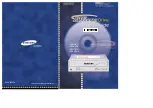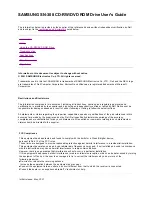
Kinco
®
Stepper Driver 2CM0870
User manual
V1.0
Kinco Electric(Shenzhen) Ltd.
To be the partner of your success
Kinco Electric (Shenzhen) Ltd.
Building 1, No.6 Langshan 1st Rd, Hi-tech Park
North, Nanshan, Shenzhen, China.
(
518057
)
http://www.kinco.cn
1. Safety Precautions
Observe safety precautions strictly.
Use a multi-meter to verify that the voltage on the driver terminals is safe;
otherwise, the electric shock may occur.
Never connect wires while the driver and the motor are working; otherwise,
the electric shock may occur.
Do not remove the housing of the driver when the power is on or the driver
is working; otherwise the electric shock may occur.
To avoid personal injury and property loss, only qualified and
service-trained personnel can operate the driver.
Do not insert any object into the driver, which may cause damage to the
equipment.
If any fault occurs to the drive, please return the driver to the maintenance
and repair center. Opening the driver without authorization or improper
operation may cause damage to the driver. Removing the enclosure of the
driver without authorization will void the warranty.
The waste driver shall be disposed of as industrial waste to avoid
environmental pollution.
Statement
:
When this driver is applied in some mechanical instruments where personal
safety is directly involved (e.g. nuclear power control, medical device,
truck, train, airplane, amusement and safety devices), be sure to install
proper fault-proof devices to avoid the possibility of personal injury.
Electronic devices are not permanently reliable! Adequate safety measures
must be taken to ensure personal and equipment safety in case of a failure.
The users must be liable for any loss resulting from equipment fault or
misoperation of the driver.
2.Product Overview
2.1 Product Acceptance
2-1 Packing list
Packing list
Article
Qty.
2CM0870 dirver
1pcs
After-sales Service Registration Form
1pcs
2PIN
,
4PIN
,
6PIN connector
1pcs for each
2kΩ metal film DIP resistor
3pcs
2.2Product naming rule
Fig 2-1 Naming rule
2.3Product Functions
AC voltage input:
Built-in rectifier and bulk capacitor.
Motor auto adaption:
The driver can automatically detect the electrical
parameters (e.g., inductance and resistance) of the motor connected
with the driver, trace the status of motor in real time, and automatically
adjust the driver parameters according to the detected motor status to
deliver the optimum driving performance. If no need to detect motor
parameter for every time power on, please refer to sheet 3-7 to set DIP
to disable this function.
Phase memory:
The driver will keep the phase of the motor in the case of
power failure with the motor. Therefore, it prevents the error caused by motor
jitter upon power-on on some application occasions. The kept phase will be
lost if the motor is replaced or the motor still rotates after the driver stops.
Automatic half current function:
Phase current will reduce to half of the set
value after motor stop in 1.5s. This function helps to reduce heat dissipation
of motor to 25%.
Test running:
If the driver is set to this status, it will automatically drive the
motor at a speed of 80RPM. At this time, the output current are the set value
and the subdivision setting becomes invalid. This function is used to check
whether the driver status is normal.
PLS+DIR and CW/CCW compatible input:
The control signal input port
of the driver supports “PLS + DIR” control signal and “CW/CCW” control
signal input.
Over-voltage alarm:
The driver will generate a over-voltage alarm if the
internal bus voltage exceeds 160VDC. Turn off the power supply in time and
reboot the driver to clear the alarm.
Over-current alarm:
The driver will generate a over-current alarm in the
case of short circuit or wrong wiring, so as to prevent driver from damage. In
this case, turn of power supply in time and check the wiring of the motor.
Reboot the driver to clear the alarm.
Under-voltage alarm:
The driver will generate a low-voltage alarm if the
internal bus voltage goes below 15 VDC. To clear the alarm, reboot the driver.
Overheat alarm:
The driver will generate a overheat alarm if the internal
temperature reaches 80°C.
2.4 Application
The drivers are applicable to various medium and small automation
equipment and instruments, including engraving machines, labeling
machines, cutting machines, numerical control machine tools, and
plotters. They are ideal choices for users in search of low vibration,
low noise, high accuracy, and high speed.
3.Product Parameters and Installation
3.1 Product Parameters
Sheet 3-1
Specification
Parameter
2CM0870
Input voltage
18-80VAC
Output current
(Peak, Unit:A)
2.4A-7.2A
Subdivision
(Unit:Pulse/rev)
400
800
---
51200
Control mode
Pulse control: PLS+DIR, CW/CCW
Input signal
PLS/DIR/ENA
Input voltage:5VDC, input current:5mA@5VDC
Valid input signal: >4VDC, Invalid:
〈
1.5VDC
Max input freq of PLS,DIR signal: 400kHz
Min pulse width: 1us
Protection
Over-voltage,
over-current,
under-voltage,
over
heat
protection.
Over-voltage
protection
>112VAC
Under-voltage
protection
<15VAC
Overheat protection
>85
℃
(Temperature of thermistor)
Sheet 3-2 Operation Environment
Cooling method
forced cooling
Environment
Operation environment
Avoid the environment with great
amount of metallic powder, oil
mist, or erosive gases.
Operation humidity
<85%, RH (non-condensing or
water drops)
Operation temperature
0
℃~
+40
℃
Storage temperature
-20
℃~
+70
℃
Net weight
2CM0870
696g
Gross weight
2CM0870
807g
Dimensions
2CM0870
151*97.5*57.5mm
Ingress protection
IP20
3.2 Description of wiring terminals
Wiring terminals of the driver are divided into three types: control
signal port, motor power cable port, and power input port.
The control terminal could accept 5V signal, single-end common-cathode
or common-anode signal. Built-in opto-coupler could isolate external
interference.
Sheet 3-3 Definition of control signal interface
Signal
Function description
DIR-(CCW-)
In the PLS+DIR control signal mode, the signal is direction
control signal, and the driver sets the rotation direction of the
motor by detecting the level of this signal.
In the CW/CCW control signal mode, the signal is the reverse
rotation control signal and the rising edge is effective.
DIR+(CCW+)
PLS-
(
CW-
)
Pulse signal. In the PLS+DIR control signal mode, the signal is
the pulse control signal and the rising edge is effective.
In the CW/CCW control signal mode, the signal is the forward
rotation control signal and the rising edge is effective.
PLS+
(
CW+
)
ENA-
This signal is offline signal. If the signal is at a high level, the
driver turns off the power supply for the motor, and the motor
rotor turns into Free status (Offline).
ENA+
Sheet 3-4 Definition of strong power interface
2-phase
3-phase
Function description
A+
/
Phase A and phase B of motor. Users could change motor run
direction by exchanging A+ and A-, or exchanging B+ and B-.
A-
/
B+
/
B-
/
AC2
Power supply, AC:18-80
AC1
3.3 Wiring Diagram
The input circuits of all control signals of the driver have been
reliably isolated through opto-coupler elements, which minimize
the interference from external electrical noises.
The twisted pairs are recommended as signal lines for
enhancing interference immunity in environments with strong
electromagnetic interference.
When external 24V control signal is applied, a 2K ohm resistor
should be connected in series.
Sheet 3-1 Control signal wiring diagram
Control signal=5V: Short R, Control signal=24V, R=2K (accessories)
Precautions for wiring:
To avoid interference on the driver, the power cables (phase wires
and power cables of the driver) shall be isolated from the signal
cables (for a distance of at least 10cm) when connecting wires for
the driver.
It is recommended that the twisted pairs be adopted for control
signal cables for the driver, and the shielding layer be grounded
reliably (to the true ground of the driver and equipment).
Due to endurance of heavy current, conductors with cross-section
no less than 1mm
2
are recommended for the motor cabling, or even
thicker ones as appropriate. The insulation terminal of motor
power cable could reduce contact resistance.
It is strictly forbidden to connect wires while the power is on;
otherwise, it may cause equipment damage and personal injury.
Please note that the power line of the motor still carries heavy
current even if the motor is in the locked status.




















